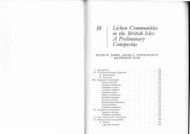Create successful ePaper yourself
Turn your PDF publications into a flip-book with our unique Google optimized e-Paper software.
lichen thallus are <strong>of</strong>ten deformed and the typical<br />
form is only acquired after first isolating and<br />
cultivating.<br />
1 Cell content <strong>of</strong> the algae ± blue-green, rarely<br />
brown-green or ± brown. No defined<br />
chromatophore, no recognizable pyrenoid,<br />
coloring diffuse (blue-green algae) 2<br />
1* Cell content <strong>of</strong> the algae pure green,<br />
yellow-green, orange-green, orange, brown-<br />
orange, or yellow with defined chromatophore,<br />
sometimes with pyrenoids (green algae) 7<br />
2 Cells single or in 2-8 gelatin packets (colonies),<br />
spherical to ellipsoidal, all more or less similar<br />
formed, never branching threads (squash<br />
preparation !) . 3<br />
2* Cells in branching threads 4<br />
3 Cells surrounded by a thin, slimy, colorless, not<br />
or indefinitely layered gelatin envelop, usually in<br />
colonies <strong>of</strong> 2-4. In very rare silicate lichens<br />
(Phylliscum) Chroococcus<br />
3* Cells with ± thick, clearly encased together, for<br />
the most part inflated gelatin envelop. The<br />
envelop <strong>of</strong>ten reddish or violet near upper surface<br />
parts <strong>of</strong> the lichen thallus (“Gloeocapsa s.str) or<br />
yellow-brown to brown colored (“Xanthocapsa”)<br />
Gloeocapsa<br />
4 Threads made up <strong>of</strong> several cell series,<br />
branching. Cells mostly brown-green, in aspect<br />
mostly ± elliptical to rectangular, 9-15 x 3-11<br />
µm. In small shrubby to filamentous lichens on<br />
seeping moist silicate rocks (Ephebe, or<br />
Spilonema) Stigonema<br />
4* Threads made up a <strong>of</strong> single cell series,<br />
unbranched or false branching 5<br />
5 Cells uniformly rounded, about 3-7 µm wide, in<br />
unbranched threads (with occasionally<br />
intercalated colorless cells: heterocysts), either<br />
lying loose in a gelatin mass and then chain- or<br />
pearl necklace form (gelatin lichens) or clustered<br />
in gelatin spheres (e.g. in Sticta, Nephroma,<br />
Pannaria, and Parmeliella) Nostoc<br />
5* Cells usually not uniformly round, broader than 5<br />
µm, not rosary-like, sometimes branched<br />
(branching <strong>of</strong>ten not to be observed in the lichen)<br />
6<br />
6 Threads not tapered toward the tips, cells oval,<br />
about 9-16 µm long, with isolated intercalated<br />
cells (heterocysts). E.g. in Polychidium,<br />
Thermutis, and Petractis Scytonema<br />
6! Threads tapered toward the tips, heterocysts only<br />
basal (characteristic difficult to see)<br />
Calothrix and related genera<br />
6* With other characteristics: algae not surely<br />
accessible.<br />
7 Cell content orange, green-orange, orange-<br />
yellow, or red-brown, in the lichen thallus more<br />
<strong>of</strong>ten even yellow-green (to green). Cells very<br />
thick-walled, cylindrical to barrel shaped, rarely<br />
globose, to branching threads, but in the lichen<br />
thallus even occurring in single cells or short cell<br />
series. Lichen thallus in the case <strong>of</strong> abrasion<br />
<strong>of</strong>ten orange, gold-yellow, gold-brown, or<br />
brown-yellow. In crustose lichens or species<br />
with fine hairy thallus threads Trentepohlia<br />
7* Cell content pure green to yellow-green.<br />
Abraded thallus not colored orange, gold-brown<br />
etc.: “pure green” algae <strong>of</strong> the order<br />
Chlorococcales and Ulotrichales 8<br />
8 Cells ± subcylindrical with rounded to slightly<br />
regenerated ends, single or united into short in<br />
short threads. Chloroplasts along the wall. In<br />
coniocarpic lichens Stichococcus<br />
8* The majority <strong>of</strong> the cells spherical, ellipsoidal to<br />
egg-shaped, single or in clumps or in small<br />
packets, not in threads . 9<br />
9 Cells narrowly ellipsoidal to broadly fusiform,<br />
<strong>of</strong>ten curved (with only one convex side), with<br />
one chloroplast against the wall, without<br />
pyrenoid (e.g. the leading species <strong>of</strong> green algae<br />
<strong>of</strong> Peltigera, and Solorina, in addition Dibaeis,<br />
and Omphalina) . Coccomyxa<br />
9* Cells spherical to short ellipsoidal 10<br />
10 Cells mostly in pairs, separated by a thin to<br />
normally thick wall, 4-7 µm in size, attacked by<br />
the lichen fungus in the form <strong>of</strong> haustoria . .<br />
micareoid green algae<br />
10* With other characteristics, if paired, then larger:<br />
(other) coccoid (coccoid or chlorococcoid) green<br />
algae (e.g. Trebouxia, predominantly spherical,<br />
1-celled, with central, ± lobed chloroplast;<br />
Myrmecia, spherical to ellipsoidal, peripheral<br />
chloroplast; Gloeocystis: cells rounded to eggshaped,<br />
surrounded by a thick gelatin envelop<br />
and united into colonies (in Bryophagus).<br />
3 Determining the <strong>Lichens</strong>:<br />
Overview <strong>of</strong> the Key<br />
1 The fruiting body is a 1-2.5 cm high stalked capfungus<br />
with lamellae on the underside. The basic<br />
thallus gray to deep green, squamulose <strong>of</strong> small<br />
globules Omphalina<br />
1 Fruiting body is not a cap-fungus or fruiting<br />
body is lacking 2<br />
2 Fruiting body is a nearly ephemeral, narrow<br />
club-like, unbranched, cream colored to above<br />
all slightly orange colored above, non lichenized,<br />
± fleshy fungus, -2 cm. Thallus <strong>of</strong> closely<br />
overlapping green, sometimes coalescing into a<br />
knobby crust. Sp. 8-12 x 1,2-3.5 µm. On peat or<br />
sandy soil Multiclavula vernalis<br />
2* Fruiting body otherwise, not a cap fungus, or<br />
fruiting body lacking . 3<br />
3 Lichen consisting <strong>of</strong> a basic small foliose,<br />
squamulose or crustose part covering the<br />
substrate and a ± upright, peg-form, cup-form or<br />
other formed, simple to branched part<br />
I: Fruticose <strong>Lichens</strong><br />
35





